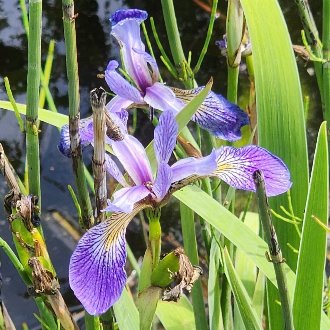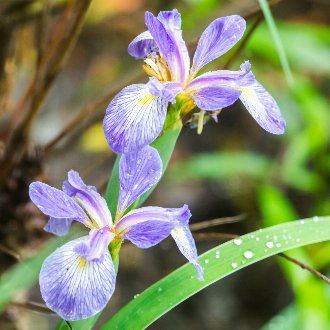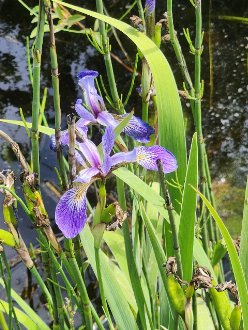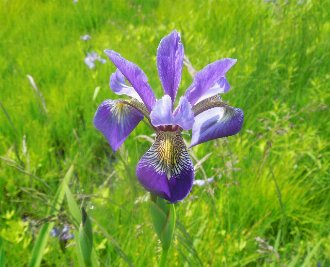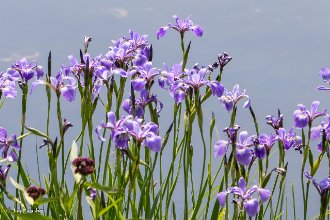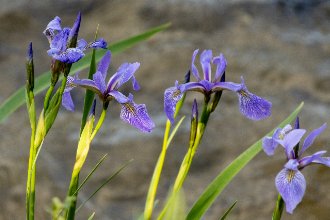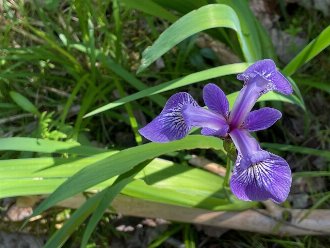Northern Blue Flag (Iris versicolor L.)
Also known as northern blueflag, harlequin blue flag, harlequin blueflag, larger blueflag, poison flag, purple iris.
↑Summary
A showy, rhizomatous perennial native to wetlands and land-water borders in the northeastern US and eastern Canada.
↑Range - Expand
| Legend | Color |
| Native | |
| Native or Not Present | |
| Expanded or Not Present | |
| Introduced or Not Present | |
| Native or Expanded | |
| Introduced |
This tentative map is based on our own research. It may have limited data on Canada and/or Mexico, and there is some subjectivity in our assignment of plants as introduced vs. expanded. Read more in this blog post.
Although this plant occurs somewhere in each of these regions, it may only occur in a small part of some or all of them.
↑Similar Plants
↑Habitat
The Northern Blue Flag is found in wetlands and along water-land borders, including in wet meadows, marshes, and shorelines of lakes, ponds, rivers, and into the oligohaline portions of brackish marshes along rivers in the coastal plain (areas with only slight salinity.) In the southern portions of its range it becomes uncommon and more restricted to higher-pH habitats including fens and alluvial swamps. In the north of its range, it is occasional in bogs.
It can be found in full sun to partial shade, but generally requires some direct sunlight.
It is more limited by competition from other plants towards the drier end of its habitat preferences, where it is easily overtopped by other plants. In areas where it is competition-limited, it tends to increase in areas where there is heavy browsing from deer or livestock. Humans have increased the habitat for this species both through increasing deer overpopulation, and introducing livestock that places heavy browsing pressure on vegetation in some places. However, humans have also harmed this species by introducing many invasive species that directly compete with it.
↑Life Cycle
Northern Blue Flag is a long-lived rhizomatous perennial with layered, branching rhizomes. It is relatively slow to establish and often grows vegetatively for a few years before blooming.
The rhizomatous habit allows this plant to adapt somewhat to changing levels of both water and soil, which are common in the habitats where it is found, by growing up or down, with older portions of rhizomes sometimes dying when they are no longer in suitable conditions.
Individual pieces of rhizome may live up to 10 years if favorable conditions persist, but through vegetative reproduction a plant can live much longer. Plants can be killed if there are radical changes to the environment, too great for the plant to adapt to, such as a large, permanent rise or drop in water levels. Plants can also die slowly from shade if growing in a swamp that develops into a closed-canopy forest, or from competition from other plants if conditions change slightly to favor other plants.
↑Faunal Associations
Like most irises, this species is toxic to mammalian herbivores and between that and its tough foliage, is usually ignored by both wild mammals and livestock. Muskrats however sometimes eat the roots. The flowers attract numerous pollinators including bumblebees, skippers, and moths.
↑Uses
This species is sometimes grown in gardens, unfortunately, much less frequently than non-native irises, some of which are invasive. It is valued for its showy flower, deer resistance, and tolerance of wet soils, including clayey and mucky soils.
In gardens, it can be grown on slightly drier ground than it would occur on in the wild, but it is best-suited to consistently wet to moist conditions, and it grows well in areas occasionally covered in standing water. It also grows well in mulch beds, tolerates a range of lighting conditions from full sun to partial shade, and is low-maintenance as long as it does not dry out for extended periods of time.
↑Related Plants
This species originated as a natural hybrid between southern blue flag (Iris virginica) and the beach head iris (Iris hookeri), during a period where their ranges overlapped. This species thrived and expanded its range, to where its parent species no longer come close to overlapping in range, but this species still overlaps with both. Some sources treat I. hookeri as a sub-taxon of beachhead iris (Iris setosa), var. canadensis but under our treatment, that species is restricted to the extreme northwest of North America and never overlapped with I. virginica in range. This species was formed as a hybrid with the populations we consider to be I. hookeri.
As would be expected for a species formed recently as a fertile hybrid, the hybrids with both parent species are fertile, and hybrids and intergrades occur in the wild where the species overlap. The hybrid with I. virginica is called the Windermere iris (Iris ×robusta), whereas the hybrid with I. hookeri is called I. ×sancti-cyrii.
↑Links & External Resources
• Iris versicolor (harlequin blueflag) | USDA PLANTS Database (About This Site)
• Iris versicolor | Go Botany (About This Site)
• Iris versicolor (Blue Flag) | Missouri Botanical Garden Plant Finder (About This Site)
• Iris versicolor | Biota of North America Project (BONAP) (About This Site)
• Iris versicolor | NatureServe Explorer (About This Site)
• Iris versicolor | Flora of North America (About This Site)
• Harlequin Blueflag | Maryland Biodiversity Project (About This Site)
• Iris versicolor (Harlequin Blueflag) | Minnesota Wildflowers (About This Site)
• Iris versicolor L. (Larger Blue Flag, Northern Blue Flag) | Digital Atlas of the Virginia Flora (About This Site)



